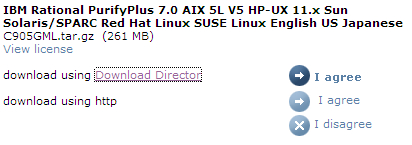Cryptic IBM Filenames
I’ve been a user of the Rational Purify product on Windows for a while and recently downloaded a Linux version to play with. The name of the download file just reminded me of how difficult it is to deal with IBM and their web site. The download file name was C905GML.tar.gz. Now how am I going to remember the purpose of that file name? Sure I can rename it to have a PurifyLinux_ prefix or something like that, but how hard would it have been to include a meaningful product prefix to the file in the first place? It just seems dealing with IBM as a small fry is overly complex. When the original Purify for Windows purchase was made I got a myriad of documents in both email pdf and snail mail post form (duplicates of each other). The pdf files all had cryptic alpha numeric names and there seemed to be multiple codes/ids that needed to be remembered for all sorts of thing e.g. license number, software site number, ibm customer number, agreement number, ibm id, passport advantage site number, proof of entitlement. This was all for a single Purify for Windows purchase. I’ve had a similar hassle with MSDN from Microsoft. They just seem to overcomplicate the customer experience. Other smaller companies can still track their customers/products without all the hassle involved. Strange how the memory of a product purchase hassle is triggered just by a cryptic download filename.
